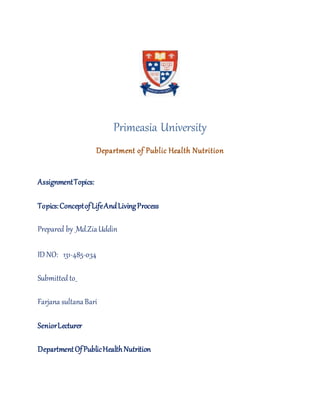
Life & living process_zia uddin
- 1. Primeasia University Department of Public Health Nutrition AssignmentTopics: Topics:ConceptofLifeAndLivingProcess Prepared by _Md.ZiaUddin ID NO: 131-485-034 Submitted to_ Farzana sultanaBari SeniorLecturer DepartmentOfPublicHealthNutrition
- 2. #Z477 Conceptof Life A cell isthe smallestunitof life thatcanreplicate independently, andcellsare oftencalledthe "building blocksof life"The cell (fromLatincella,meaning"small room") isthe basicstructural,functional,and biological unitof all known livingorganisms Cells: All livingthingsare made uptocellswhichare unicellularormulticellularorboth Cellsconsistof cytoplasmenclosedwithinamembrane,whichcontainsmany biomolecules such as proteins andnucleicacids.Organismscanbe classifiedasunicellular(consistingof asingle cell; includingbacteria) ormulticellular(includingplantsandanimals).While the numberof cellsinplants and animals variesfromspeciestospecies,humanscontainmore than10 trillion(1012) cells.Mostplant and animal cellsare visibleonlyunderamicroscope,withdimensionsbetween1and 100 micrometres, The cell was discoveredby RobertHooke in1665 Cellsare of two types,eukaryotic,whichcontainanucleus,andprokaryotic,whichdonot.Prokaryotes are single-celledorganisms,while eukaryotescanbe eithersingle-celledormulticellular.
- 3. Prokaryotic cells Prokaryoticcellswere the firstformof life onEarth,characterisedbyhavingvital biological processes includingcell signalingandbeingself-sustaining.Theyare simplerandsmallerthaneukaryotic cells,andlackmembrane-boundorganellessuchasthe nucleus.Prokaryotesinclude twoof the domains of life,bacteriaandarchaea.The DNA of a prokaryoticcell consistsof asingle chromosome thatisin directcontact withthe cytoplasm.The nuclearregioninthe cytoplasmiscalledthe nucleoid. Eukaryotic cells Plants,animals,fungi,slimemoulds,protozoa,andalgae are all eukaryotic.These cellsare aboutfifteen timeswiderthana typical prokaryote andcan be as much as a thousandtimesgreaterinvolume.The maindistinguishingfeature of eukaryotesas comparedtoprokaryotesis compartmentalization: the presence of membrane-boundorganelles (compartments) inwhichspecificmetabolicactivitiestake place. Subcellularcomponents All cells,whetherprokaryoticoreukaryotic,have amembrane thatenvelopsthe cell,regulateswhat movesinand out(selectivelypermeable),andmaintainsthe electricpotential of the cell.Insidethe membrane,the cytoplasmtakesup mostof the cell'svolume.There are alsootherkinds of biomolecules incells.Thisarticle liststheseprimarycomponentsof the cell,thenbrieflydescribes theirfunction. Membrane The cell membrane,orplasmamembrane,isabiological membrane thatsurroundsthe cytoplasmof a cell.Inanimals,the plasmamembrane isthe outerboundaryof the cell,while inplantsandprokaryotes it isusuallycoveredbya cell wall.Thismembrane servesto separate andprotecta cell fromits surroundingenvironmentandismade mostlyfroma double layerof phospholipids,which are amphiphilic(partly hydrophobicandpartly hydrophilic).Hence,the layeriscalledaphospholipid bilayer.The membrane issaidtobe 'semi-permeable',inthatitcan eitherletasubstance (moleculeorion) passthroughfreely,passthroughtoa limitedextentornotpassthroughat all. Cytoskeleton The cytoskeletonactstoorganize andmaintainthe cell'sshape;anchorsorganellesinplace;helps duringendocytosis,the uptake of externalmaterialsbyacell,and cytokinesis,the separationof daughtercellsaftercell division;andmovespartsof the cell inprocessesof growthand mobility.The eukaryoticcytoskeletoniscomposedof microfilaments,intermediate filaments andmicrotubules. Organelles Organellesare partsof the cell whichare adaptedand/orspecializedforcarryingoutone or more vital functions,analogoustothe organsof the human body(suchas the heart,lung,and kidney,witheach organ performingadifferentfunction).Botheukaryoticandprokaryoticcellshave organelles,but prokaryoticorganellesare generallysimplerandare not membrane-bound. There are several typesof organellesinacell.Some (suchas the nucleus andgolgi apparatus) are typicallysolitary,while others(suchas mitochondria,chloroplasts,peroxisomesandlysosomes) canbe numerous(hundredstothousands).The cytosol isthe gelatinousfluidthatfillsthe cell andsurrounds the organelles.
- 4. Eukaryotic Human cancer cellswithnuclei (specificallythe DNA) stainedblue.The central andrightmostcell are ininterphase,sothe entire nucleiare labeled.The cell onthe leftisgoingthrough mitosisanditsDNA has condensed. Cell nucleus:A cell'sinformationcenter,the cell nucleus isthe mostconspicuousorganelle foundin a eukaryoticcell.Ithousesthe cell's chromosomes,andisthe place where almostall DNA replication and RNA synthesis(transcription) occur.The nucleusisspherical andseparatedfromthe cytoplasmbya double membrane calledthe nuclearenvelope.The nuclearenvelope isolatesandprotectsacell'sDNA fromvariousmoleculesthatcouldaccidentallydamage itsstructure orinterferewithitsprocessing. Duringprocessing, DNA istranscribed,orcopiedintoaspecial RNA,calledmessengerRNA (mRNA).This mRNA isthentransportedoutof the nucleus,where itistranslatedintoaspecificprotein molecule. The nucleolus isaspecializedregionwithinthe nucleuswhereribosomesubunitsare assembled.In prokaryotes,DNA processingtakesplace inthe cytoplasm. Mitochondriaand Chloroplasts:generate energyforthe cell. Mitochondriaare self-replicating organellesthatoccurin variousnumbers,shapes,andsizesinthe cytoplasmof all eukaryotic cells.[3] Respiration occursinthe cell mitochondria,whichgenerate the cell'senergyby oxidative phosphorylation,usingoxygentorelease energystoredincellularnutrients(typicallypertaining to glucose) togenerate ATP.Mitochondriamultiplyby binaryfission,like prokaryotes.Chloroplastscan onlybe foundinplantsand algae,andtheycapture the sun'senergytomake carbohydrates throughphotosynthesis. Endoplasmicreticulum:The endoplasmicreticulum (ER) isatransportnetworkformoleculestargeted for certainmodificationsandspecificdestinations,ascomparedtomoleculesthatfloatfreelyinthe cytoplasm.The ER has twoforms:the roughER, whichhas ribosomesonitssurface thatsecrete proteins intothe ER, and the smoothER, whichlacks ribosomes. The smoothERplaysa role incalcium sequestrationandrelease. Golgi apparatus: The primaryfunctionof the Golgi apparatusis to processandpackage the macromolecules suchas proteins andlipidsthatare synthesizedbythe cell. Lysosomesand Peroxisomes:Lysosomes containdigestive enzymes (acidhydrolases).Theydigest excessorworn-outorganelles,foodparticles,andengulfed virusesorbacteria.Peroxisomes have enzymesthatridthe cell of toxicperoxides.The cell couldnothouse these destructiveenzymesif they were notcontainedina membrane-boundsystem. Centrosome:the cytoskeletonorganiser:The centrosome producesthe microtubules of acell – a key componentof the cytoskeleton.Itdirectsthe transportthroughthe ER and the Golgi apparatus. Centrosomesare composedof two centrioles,whichseparate during celldivision andhelpinthe formationof the mitoticspindle.A single centrosome ispresentinthe animal cells.Theyare alsofound insome fungi andalgae cells. Vacuoles:Vacuoles sequesterwaste productsandinplantcellsstore water.Theyare oftendescribedas liquidfilledspace andare surroundedbya membrane.Some cells,mostnotably Amoeba,have contractile vacuoles,whichcanpumpwaterout of the cell if there istoomuch water.The vacuolesof plantcellsandfungal cellsare usuallylargerthanthose of animal cells.
- 5. Eukaryoticand prokaryotic Ribosomes:The ribosome isa large complex of RNA andprotein molecules. Theyeachconsistof two subunits,andact as an assemblyline where RNA fromthe nucleusisusedtosynthesiseproteinsfrom aminoacids.Ribosomescanbe foundeitherfloatingfreelyorboundtoa membrane (the rough endoplasmaticreticulumineukaryotes,orthe cell membrane inprokaryotes). Cellularprocesses Cell growth and Metabolism: Betweensuccessive cell divisions,cellsgrow throughthe functioningof cellular metabolism.Cell metabolismisthe processbywhichindividual cellsprocessnutrientmolecules.Metabolismhastwo distinctdivisions: catabolism,inwhichthe cell breaksdowncomplexmoleculestoproduce energy and reducingpower,andanabolism,inwhichthe cell usesenergyand reducingpowertoconstruct complex moleculesandperformotherbiological functions.Complex sugarsconsumedbythe organism can be brokendownintosimplersugarmoleculescalled monosaccharides suchasglucose.Once inside the cell,glucose isbrokendowntomake adenosine triphosphate (ATP),amoleculethatpossesses readilyavailable energy,throughtwodifferentpathway. Living Process In science,the broadestgroupingsare livingandnon-living.Alllivingthingsshare life processessuchas growthand reproduction.Mostscientistsuse sevenlife processesorcharacteristicstodetermine whethersomethingislivingornon-living. All livingthingsare calledorganisms,bothplantsandanimalsare livingorganisms.Buthow we decide whethersomethingisliving ornon-livingdependson 7 life processes. 1. Movement Both animalsandplantshave the abilitytomove.Plantsare rootedandmove slowlyastheygrow.Their roots move downintothe soil andtheirstemsmove uptowardsthe light.Animalsonthe other hand move quicklyandcan move theirentire bodies.Theycanmove insearchof food,shelterorto avoid danger. 2. Respiration Respirationisthe processof extractingenergyoutof the foodwe eat.All livingthingsrespirebecause theyneedenergyto grow,to replace wornoutparts and to move.Respirationtakesplace inthe mitochondriaof the cell.There are twotypesof respiration,withandwithoutoxygen.Aerobic respirationusesoxygenandreleasesalarge amountof energy.Anaerobicrespiration doesnotrequire oxygenandreleasesasmalleramountof oxygen. 3. Sensitivity All livingorganismsare sensitive,thismeansthattheyhave anawarenessof changesintheir environment.Animalsrespondquicklytostimuli suchasheat,light,sound,touch andchemicalswhich have taste and smell.Onthe otherhandplantsgenerallyappearlesssensitive andtheirresponse is slower.Plantsrespondtolightbymovingtheirleavestowardsit,the flowersof some plantsopeninthe morningandclose at nightwhenitis dark.Some plants,however,dorespondquicklysuchasthe Venus flytrapresponse totouch. 4. Growth
- 6. All livingorganismsgrow.Plantscontinuegrowingthroughouttheirlives.Animalsstopgrowingonce theyreach adulthood.Evenwhengrowthstops,materialswithinananimal’sbodyare still being replacedfromitsfood. 5. Excretion All livingthingsmake waste productsthesecanbe uselessorharmful toitand therefore needtobe got rid of.Excretionisthe processof gettingridof metabolic waste.Plantsstore waste substancesintheir leaves,the waste isremovedwhentheirleavesfall off.Animalsbreathe outwaste carbondioxide,other waste substancesleave the bodyinurine andsweat.Note:Gettingridof faecesorundigestedfoodis not excretionbutejection. 6. Reproduction All livingthingsmustproduce offspringlike themselvesinorderfortheirspeciestosurvive.Thisisthe processknownas reproduction.Plantsproduceseedsthatgive rise tonew plantsof the same species. Animalslayeggsorhave babies.Reproductioncanbe of twotypes,Sexual whichinvolvestwoparents and the unionof two gametesandAsexual where one parentcanreproduce itself. 7. Nutrition Nutritionisneededforenergyandgrowth,bothplantsandanimalsneedfood.Plantsare able tomake theirownfoodby photosynthesis.Theyuse sunlighttoturnsimple moleculeslikecarbondioxide and waterintomore complex carbohydrate molecules.Animalsare unable tomake theirownfoodsorely on otherplantsand other animalsfortheirnutrition.Animalstake incomplex substancesandbreak themdownintosmall,simple,soluble moleculeswhichcanbe usedforenergyandgrowth. References: http://www.srmuniv.ac.in/sites/default/files/downloads/Introduction_To_Biochemistry.pdf https://www.sciencelearn.org.nz/resources/14-characteristics-of-living-things http://www.passmyexams.co.uk/GCSE/biology/life-processes.html http://www.fsg.rnu.tn/imgsite/cours/Life%20processes%20(R%C3%A9par%C3%A9).pdf https://en.wikipedia.org/wiki/Cell_(biology)
